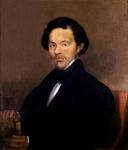Born: ±1795, somewhere near Harrisburg, Pennsylvania
(However, other sources say, 1797, Cecil County, Maryland)
Lived: ±1816-1830s, Columbia, Pennsylvania
Died: November 4, 1873, Philadelphia, Pennsylvania
The colorful, rags-to-riches saga of Stephen Smith traces his rise from slavery and poverty to wealth. Smith learned the lumber business while still a slave and, when free, owned a thriving lumber enterprise. Smith found a way to manage his various business ventures and at the same time become immersed in antislavery and religious activities. Called the richest antebellum black, he shared his wealth generously with a number of institutions.
Born near Harrisburg, Pennsylvania, in Dauphin County around 1795, Stephen Smith was the son of a slave woman, Nancy Smith; his father was unknown. Young Stephen was indentured to General Thomas Boude on July 10, 1801, when he was four or five years old. Boude was a former Revolutionary War officer from Lancaster County, Pennsylvania who allowed Smith to manage his entire lumber business as Smith approached manhood. Smith borrowed $50 on January 3, 1816, to purchase his freedom, and in that same year, he purchased release from his indenture. On November 17, 1816, Smith married Harriet Lee, who worked as a servant in the Jonathan Mifflin home. Already equipped with entrepreneurial skills, Smith opened a lumber business and became involved in lucrative real estate operations while his wife operated an oyster and refreshment house.

Stephen Smith became involved in civil rights activities early on. He opposed the policies of the American Colonization Society and demonstrated his opposition in 1831 when he led free blacks in Columbia in a public meeting. In 1834, Smith joined such men as David Ruggles, John Peck, Abraham Shadd, and John B. Vashon who were the first black agents for Freedom’s Journal and later for The Emancipator. They were asked to secure subscriptions to the papers and collect what was called arrearages.
The astute businessman opened a lumber business in Columbia, Pennsylvania, and soon prospered. The risky work on the Underground Railroad did not intimidate such abolitionists as Smith and William Whipper. These two abolitionists and businessmen of Columbus, Pennsylvania escaped bodily harm and jail sentences for secreting slaves. Smith’s success in real estate ventures and work as an abolitionist disturbed whites who led a mob in an attack on his office in August 1834, spurring a race riot, followed by a second one in October. They wanted to frighten Smith and force him and other black real-estate owners to sell their property below market value and leave town. They also accused Smith of inflating the value of his property. William F. Worner’s account of the Columbia riots noted the letter that Smith received in 1835: “You must know that your presence is not agreeable, and the less you appear in the assembly of the whites the better it will be for your black hide, as there are great many in this place that would think your absence from it a benefit, as you are considered an injury to the real value of property in Columbia. You have [sic] better take the hint.” In the 1830s, Smith and several antebellum blacks were members of various boards; for Smith, it was the Columbia Bank. He may have been the bank’s largest stockholder, yet he could not become president due to bank rules preventing blacks from holding that post. His status, however, allowed him to name the white man who would be president.